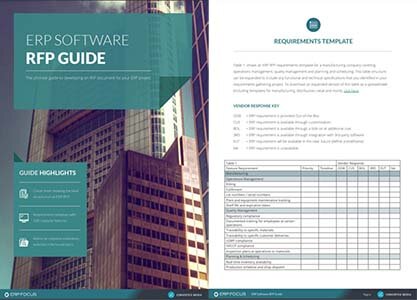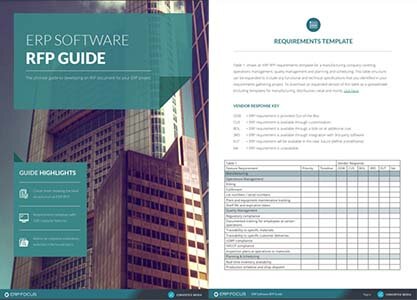An RFP is a valuable tool in your ERP vendor search
When used correctly, the Request for Proposal (RFP) can be a vital instrument in your ERP software selection process. Your organization can use this tool to ensure you find the best ERP vendor in the marketplace; one that will align well with your company’s business processes and functionality as well as becoming a satisfactory system partner moving forward. Make the RFP a valuable part of your selection process. Keep this in mind, the more tailored the RFP is to your organizational needs, the more apt the ERP software vendor will be to understand your requirements and to demonstrate why they might be a good match for your requirements.
Ensure your ERP RFP gets results that matter by considering the following points.
1. Make it bespoke
Ensure RFP questions represent your company. The temptation will be to use an RFP template. While a template can be a good starting place for your RFP, it can be far too general in nature, with many questions not relevant to your company’s needs. A well-crafted RFP, specifically delineating your company’s critical needs and eliminating those that are not, will be essential in helping you evaluate ERP vendors, ERP software functionalities, and the technical requirements of the ERP solution.
Recommended reading: ERP software RFP guide - new 2016 version
2. Do your research
Managers and department heads need to get input from their staff about the company’s critical needs and how an ERP software solution will benefit their particular job or production area. What specific functionalities do they require from the ERP software? How will these features benefit the organization? What are the technical and training challenges they’ll likely face with ERP implementation? Lists of criteria, comments, and concerns should be compiled and organized. This exercise is invaluable to the process of producing your ERP RFP.
3. Be specific
The language of your RFP should be direct and edited to succinctly communicate the purpose of the RFP and your company’s key requirements. Rank your company’s needs from the most essential items to the nice-to-haves to some future state, understanding that the main focus is on those features critical to the organization’s success. Also, describe in detail any unique requirements or customizations you may require. Never assume the vendor will “fill in the blanks” about what you need. Finally, let the ERP vendors know what sections of the RFP carry the most weight, or inform them that their presentation must follow the sequence of the RFP. Your RFP might also give instructions for hands-on demos and/or testing.
Never assume the vendor will “fill in the blanks” about what you need.
4. Limit confusion about the RFP, the selection process, and your company
The value of a well-constructed RFP has been noted. Now what? How will it be used to lead to a proper end result? This is where the rubber meets the road. If the RFP is concise, well-constructed, and represents your company, then it will aid in the process as selected vendors come onsite for a discovery visit to learn more about your business. All too often a templated RFP is not edited, and what the ERP vendor learns during discovery versus what is represented on the RFP do not match, adding confusion to the process. Remember, the ERP vendors will be learning more about your company from their interactions. Doing what you can to limit confusion from start to finish in this process is critical to its success.
5. Disclose how your company makes the final decision
Yours may be a top-down process, or perhaps a group of key-users and IT professionals spearhead the selection process from bottom-to-top. Maybe a committee is empowered to make search and selection decisions. Let your ERP vendors know which decision-makers they should be targeting with their RFP, how the RFP will be evaluated, what to expect of the final selection process, and the timeline.
6. Demystify your corporate culture
Your culture influences your actions, decisions, goals, and strategies. Identify yours, and share these observations within the RFP. Do you operate in a hierarchical manner within a strict corporate structure and headed by a strong CEO who desires stability? Perhaps your company is more collaborative, with room for flexibility and team building? Or are you dynamic, creative, and entrepreneurial, willing to take some risks and experiment with innovation? Perhaps important decisions are made emotionally rather than analytically? Understanding these factors will help you evaluate how the ERP RFP will be used in final selection and if the RFP process will be ultimately valuable for your company.
7. Verify the ERP vendor’s integrity and trustworthiness
There should be mutual trust between your company and the ERP vendor. Build opportunities into the RFP for the ERP vendor to use verifiable information––whether scenarios, statistics, quotes, or other applicable data––and structure the RFP in such a manner that a citation can be used. Conversely, share enough pertinent information about your company’s history, philosophy, long-range goals, etc. that the ERP vendor can use it within the formal proposal.
Finding the right ERP software vendor for your company is important. Use all the tools at your disposal. This includes your ERP RFP. Do the research to gather the pertinent information you need, and supply the specific details of your needs and expectations. In addition to the important technical information and specifications your RFP addresses, it can also be a powerful in-depth conversation starter, a way to share cultures and business philosophies, a mechanism to develop mutual trust, and ultimately, a vehicle for uncovering the perfect ERP software for your company.
Free white paper

ERP Software RFP Guide & Template
The comprehensive guide to developing an RFP document for your ERP project

Featured white papers
-

ERP Software RFP Guide & Template
The comprehensive guide to developing an RFP document for your ERP project
Download
Related articles
-

A complete ERP RFP template & guide (includes free template)
All you need to know construct a foolproof ERP RFP, including a customizable template
-

CMMC Compliance: What Aerospace and Defense Manufacturers Need to Know
Key insights on CMMC compliance, deadlines, and securing DoD contracts with CMMC 2.0 certificatio...
-
![Three things wrong with your ERP RFP [Image by DC Studio on Freepik] Three things wrong with your ERP RFP [Image by DC Studio on Freepik]](/pictures/W1siZiIsIjIwMjUvMDEvMTMvOWt2bXYwZWVhal9UaHJlZV90aGluZ3Nfd3Jvbmdfd2l0aF95b3VyX0VSUF9SRlBfSW1hZ2VfYnlfRENfU3R1ZGlvX29uX0ZyZWVwaWtfLmpwZyJdLFsicCIsInRodW1iIiwiNDAweDI2NiMiXSxbInAiLCJlbmNvZGUiLCJqcGciLCItcXVhbGl0eSA4NSJdXQ/Three%20things%20wrong%20with%20your%20ERP%20RFP%20%5BImage%20by%20DC%20Studio%20on%20Freepik%5D.jpg?sha=699520086e1967d0)
Three things wrong with your ERP RFP
Things that could be holding your ERP RFP back, and how to make it better

